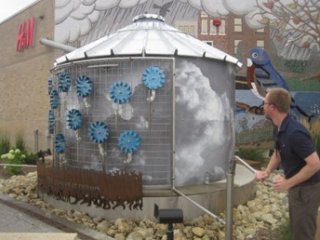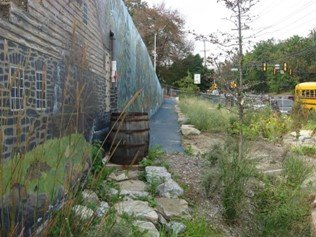Capturing Stormwater as Source Water for Reuse Resources

Stormwater, especially in urban environments on the east coast, can overwhelm the capacity of many wastewater treatment plants that must capture the stormwater via combined sewer overflows (CSO) and treat it before releasing it back into a stream. The amount of stormwater a community receives is changing significantly due to climate change, frequently resulting in an increased volume of water flowing into CSOs, which creates a financial burden for utilities treating this water. However, stormwater has the potential to be an asset for communities interested in storing it in underground aquifers for future uses. There are many potential beneficial uses of appropriately treated stormwater including potable water, aquifer recharge, and urban park development.
Water reuse is the practice of reclaiming water from a variety of sources, treating it, and reusing it for beneficial purposes. The following resources relate to stormwater as a source water for reuse; for information on uses, please visit the Water Reuse Resource Hub by End-Use Application.
On this page:
Key Resources

The following are a sampling of the key water sector resources that are freely available to support water practitioners interested in developing stormwater capture and use projects. Visit the Water Reuse Information Library for additional water reuse materials.
- 2025 Risk Based Framework for Developing Microbial Treatment Targets for Water Reuse – This EPA document provides detailed scientific information that states and Tribes can use to develop risk assessments and microbial treatment targets that support safe potable and non-potable water reuse.
- Stormwater Capture and Use Infographics (2023) – These two infographics from EPA demonstrate how SCU can be integrated into the urban environment. These graphics cover both onsite and community scale reuse for different potable and non-potable applications. Stormwater practitioners can use these graphics to engage stakeholders and decision-makers to explain SCU, show how it can support different water quality and supply goals, and help build support for new projects.
- Community-Scale Rainwater and Stormwater Capture and Use
- Onsite Rainwater and Stormwater Capture and Use
- Pure Potential: The Case for Stormwater Capture and Use (2022) – This report summarizes the outcomes of an expert convening held in 2021 to identify the opportunities and challenges that communities face when pursuing stormwater capture and use projects. Specific priorities are identified to resolve many of these challenges on topics such as policy, partnerships, funding needs, and treatment standards.
- The Untapped Potential of California’s Urban Water Supply: Water Efficiency, Water Reuse, and Stormwater Capture (2022) – This Pacific Institute report quantifies Californian water strategies that reduce water waste and increase local water supplies. Estimates of available water for reuse and urban stormwater capture potential lead authors to conclude that these options should be expanded to combat drought and ensure long-term water supply reliability.
- Enhanced Aquifer Recharge of Stormwater in the United States: State of the Science Review (2021) – Groundwater aquifers throughout the U.S. are being overused and depleted. There is growing interest in enhanced aquifer recharge (EAR) to augment drinking water supplies, replenish groundwater, and restore streamflow. This EPA report focuses on one aspect of EAR: the intentional recharge of aquifers using stormwater from developed lands (as opposed to agricultural/rural). There is a need for improved understanding of best practices for effective, safe EAR using stormwater in different development and hydrogeologic settings.
- Using Graywater and Stormwater to Enhance Local Water Supplies (2016) – In this report, the National Research Council provides an assessment of the risks, costs, and benefits of capturing and treating greywater and stormwater for different potable and non-potable purposes. This report includes estimates of potable water savings from these practices along with some of the associated legal and regulatory issues.
Project Examples
Los Angeles County, California Reuses Stormwater to Meet Demand
Los Angeles (LA) County experiences extreme water stress and has implemented numerous reuse projects focused on non-potable and indirect potable reuse of treated wastewater. However, due to increased water efficiency and lowered residential use during droughts, less and less wastewater has been available for existing reuse applications. In LA County, wastewater and stormwater are conveyed through separate sewer networks, which prevent stormwater from overwhelming the sanitary sewer and wastewater treatment plants’ design capacity. However, the separate sewers also prevent stormwater from being available for water reuse at conventional wastewater reclamation plants. Therefore, the LA County Sanitation Districts (LACSD) started building stormwater-sewer diversion projects – engineered structures that bring stormwater into the sanitary sewer at a controlled rate. Stormwater-sewer diversion projects have been funded by the local Safe Clean Water Program and have been implemented after successful collaborations across LA County agencies. These stormwater-sewer diversion projects, which are set for expansion across the region, will help LA County secure a reliable water source for recycled water into the future.
Washington D.C.'s Canal Park Captures and Reuses Stormwater for Community Benefits
In Washington, D.C., a former bus parking lot has been transformed into a community park and a model beneficial stormwater capture and use project that is also helping to reduce pollution in the Anacostia River. Stormwater that lands onsite and on neighboring streets is captured and managed with bioretention, tree planters, and cisterns, then reused to meet most of the park’s water supply needs for landscape irrigation, fountains, and an outdoor ice rink. Canal Park’s green spaces have provided the community with social, economic, and environmental benefits while reducing pollution in the Anacostia River.
